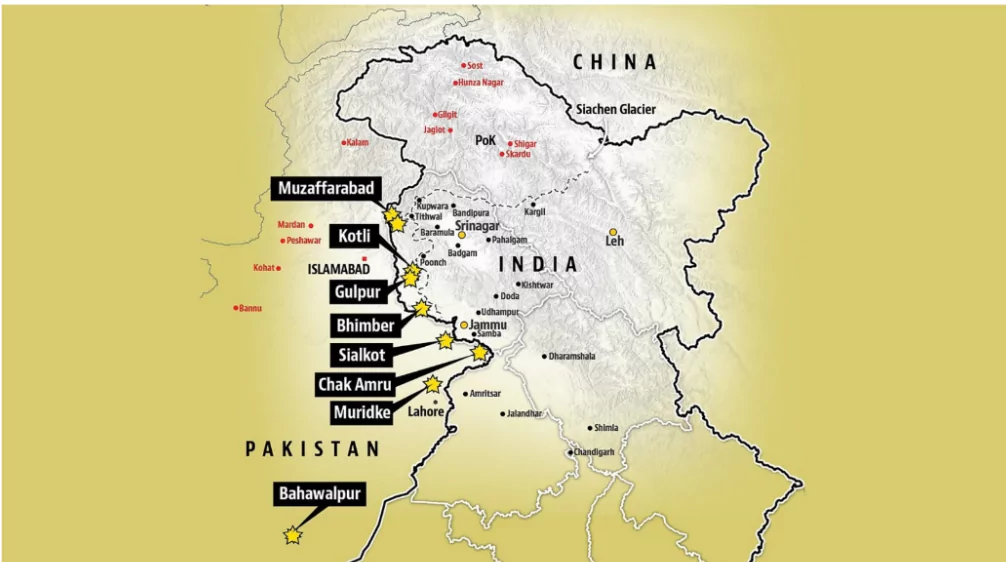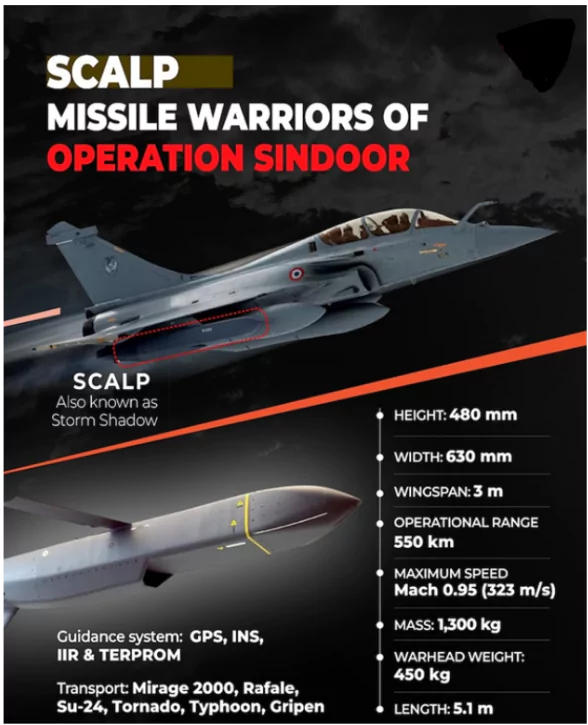India launched ‘Operation Sindoor’ in response to the April 22 Pahalgam terror attack that killed 25 Indian tourists and one Nepali citizen.
- The Defence Minister informed that ~100 terrorists were killed in precise strikes on 9 terror hideouts in Pakistan and PoK.
- A day after Operation Sindoor, the Indian Armed Forces neutralised an air defence system in Lahore, the government said.
About the Sindoor Operation

- Operation Sindoor is a military operation launched by India on May 7, 2025, targeting terrorist infrastructure in Pakistan and Pakistan-occupied Kashmir (PoK).
- The targets included key terrorist hubs in Bahawalpur, Muridke (Pakistan Punjab), Muzaffarabad, and Kotli (PoK), known bases of Jaish-e-Mohammed and Lashkar-e-Taiba.
- The operation showcased India’s strategic restraint and commitment to punishing those responsible for cross-border terrorism.
Response of Major World Powers
- United Nations Security Council (UNSC): Rejected Pakistan’s appeal to censure India following the Operation Sindoor strikes.
- Implication: Marked tacit acceptance of India’s right to self-defence under UN Article 51.
- Reflects growing international fatigue with Pakistan’s repeated attempts to seek equivalence with India in global forums.
- United States: Actively in touch with both India and Pakistan, but not rushing into mediation as seen in earlier crises.
- Strategic Outlook:
- Seeks to prevent escalation, especially under the nuclear shadow.
- Considers the Pakistan Army a useful counter-terror ally, yet has shown implicit support for India’s counter-terror strikes.
- Precedent: Cited Iran’s January 2024 strikes inside Pakistan as an accepted form of cross-border retaliation against terrorism.
- Europe (Including U.K.): Muted but supportive of India’s defensive posture.
- Policy Limitations:
- Historically tied to Pakistan via aid and counter-terror coordination.
- Aid to Pakistan includes anti-terrorism clauses, often waived or loosely enforced.
- Despite this, no major European country has publicly condemned India.
- China: Continues to support Pakistan diplomatically, especially at the UNSC.
- Behaviour: Acts as a shield for Pakistan in international forums.
- Ambiguity: While backing Pakistan politically, also shows discomfort with the instability created by its terror proxies.
|
Pakistan’s Response
- Pakistan invoked Article 51 of the UN Charter claiming India’s action breached international norms, while India cited the same Article to justify self-defence.
About Article 51 of United Nations Charter
- Article 51 of the UN Charter affirms the “inherent right of individual or collective self-defence if an armed attack occurs against a UN member state.”
- Any defensive measures taken under Article 51 must be reported to the UN Security Council and are subject to its authority to maintain international peace.
- The provision recognizes the legitimacy of unilateral defensive action until the UNSC takes collective security measures.
|
Operation Sindoor: Impact on Pakistan
- Strategic Deterrence Recalibrated: Pakistan’s long-standing belief in India’s reluctance to cross borders militarily has been dismantled.
- This marks the deepest penetration (up to 150 km) since 1971, surpassing even Balakot (2019) and the 2016 surgical strikes.
- Terror Infrastructure Degraded: India destroyed critical terrorist camps that had trained attackers responsible for past attacks including 26/11 Mumbai and Pulwama.
- Strikes were based on detailed intelligence inputs including HUMINT and technical surveillance, confirming activity at Sawai Nala, Markaz Taiba, and Subhanallah mosque camps.
- Psychological and Military Pressure: The operation imposed psychological strain on Pakistan’s armed forces and public confidence.
- Pakistan’s Prime Minister vowed retaliation, but conflicting signals from the Defence Minister indicated internal confusion.
- Diplomatic Isolation: Pakistan failed to garner significant international support post-strikes.
- UNSC rejected Islamabad’s call to censure India; global powers, including the US, showed tacit acceptance of India’s right to self-defence.
- Internal Political and Social Discontent: The Pakistani military’s dominance in governance faces rising public resentment.
- With Imran Khan jailed and democracy weakened, the army’s role is under scrutiny amid economic decline and mismanagement of internal insurgencies.
- Exposure of Civilian Vulnerability: Civilian deaths (as claimed by Pakistan) highlight internal unpreparedness and risks of hosting terror camps in populated areas.
- India maintained its claim of avoiding civilian/military targets, but Pakistan’s own narrative confirms its use of dual-use facilities.
- Economic and Infrastructural Strain: Strikes, combined with the suspension of the Indus Waters Treaty, stress Pakistan’s fragile economy.
- Water is a deeply emotional and strategic issue in Pakistan; prior allegations of a “water war” were resurrected.
Operation Sindoor: Impacts on India
- Strengthening of Conventional Deterrence: India re-established its credibility by demonstrating willingness and ability to launch deep, precise strikes.
- The strikes were more extensive than Balakot 2019 and Uri 2016, showing evolution in India’s military doctrine.
- Political and National Unity: The operation generated bipartisan political support and strong public endorsement.
- Operation Sindoor was described as “measured, non-escalatory, and responsible,” which helped unite domestic opinion.
- Diplomatic Credibility and International Legitimacy: India’s restrained yet firm action gained quiet international acceptance.
- The UNSC declined Pakistan’s request to restrain India; most global powers accepted India’s right to self-defence under UN Article 51.
- Operational and Intelligence Validation: Demonstrated India’s enhanced military capability, intelligence integration, and precision targeting.
- Use of BrahMos, SCALP, drones, and loitering munitions; target selection corroborated by technical and human intelligence (HUMINT).
- Increased Pressure on Defence Preparedness: Sets a precedent for more rapid, decisive retaliation, requiring continued readiness and modernization.
- India’s aim is to build overwhelming dominance over Pakistan while keeping the northern border secure.
- Social Fabric and Internal Security Challenges: Risk of communal tension and mistrust post-attack required cautious handling to avoid polarization.
- The Pahalgam attack was aimed at disturbing normalcy in Kashmir and creating communal rifts.
Past Military Operations by India against Pakistan
- Operation Riddle (1965): Launched during the 1965 Indo-Pak war in response to Pakistan’s incursions into Jammu & Kashmir under Operation Gibraltar.
- Indian forces targeted Lahore and Kasur, leading to a full-scale war and eventual Tashkent Agreement.
About Tashkent Agreement
- The Tashkent Agreement, signed on January 10, 1966, in Tashkent, Uzbekistan, was a peace treaty between India and Pakistan that aimed to end the 1965 Indo-Pakistani War.
- It was signed by Indian Prime Minister Lal Bahadur Shastri and Pakistani President Muhammad Ayub Khan.
- The agreement included provisions for troop withdrawals to pre-August 5, 1965, positions, adherence to the ceasefire line, and efforts to create good-neighborly relations.
|
- Operation Ablaze (1965): A pre-emptive troop mobilisation by India to prepare for conflict after border skirmishes in the Rann of Kutch.
- The two operations effectively pushed back Pakistan and led to the Tashkent Agreement brokered by the Soviet Union.
- Operation Cactus Lily (1971): Also known as The Meghna Heli Bridge or the Crossing of the Meghna, was an air assault operation conducted in December 1971 during the Bangladesh Liberation War.
- It was instrumental in Pakistan’s surrender and the creation of Bangladesh.
- Operation Trident (1971): A naval strike on Karachi port using missile boats on December 4, inflicting heavy damage on Pakistani naval assets.
- It marked India’s first use of anti-ship missiles in combat.
- Operation Python (1971): A follow-up naval strike on Karachi targeting oil depots and ships.
- The operation crippled Pakistan’s maritime fuel supply and reinforced India’s dominance at sea.
- Operation Meghdoot (1984): India preemptively occupied strategic heights in the Siachen Glacier to counter Pakistani attempts at territorial claims.
- It gave India control over key passes and initiated the ongoing Siachen conflict.
- Operation Vijay (1999): India launched a massive military campaign to evict Pakistani infiltrators from Kargil during the 1999 conflict.
- It resulted in India recapturing all occupied posts and securing international support.
- Operation Safed Sagar (1999): The Indian Air Force’s contribution to the Kargil War, involving precision airstrikes on enemy positions.
- It was the first large-scale use of air power in Kashmir since 1971.
- Surgical Strikes (2016): Special forces crossed the LoC to destroy terror launch pads after the Uri attack.
- This marked a shift from strategic restraint to proactive cross-border retaliation.
- Operation Bandar (2019): Airstrikes were carried out on Jaish-e-Mohammed’s Balakot training camp in response to the Pulwama suicide bombing.
- It was the first deep aerial strike inside Pakistan since 1971.
India’s Precision-Strike Arsenal

- SCALP Cruise Missile (Storm Shadow)
- A long-range (550 km), air-launched cruise missile developed by European firm MBDA, used for deep strikes on high-value, fortified targets.
- Deployed from Rafale jets, it features stealth, GPS/INS guidance, and has been combat-proven in Iraq, Libya, Syria, and Ukraine.
- HAMMER Precision-Guided Bomb
- Medium-range (70 km) modular bomb by France’s Safran, with GPS, infrared, and laser guidance for dynamic/mobile targets.
- Enhances Rafale’s strike versatility, allowing precision hits on terror camps without crossing borders.
- Loitering Munitions (Kamikaze Drones)
- Surveillance + strike drones that loiter over targets before executing autonomous precision strikes.
- Provide real-time intel and reduce pilot risk, crucial for counter-terror ops in hostile terrain.
Pakistan’s Terror Networks & State Sponsorship
Historical Roots of Pakistan’s Terror Ecosystem
- Soviet-Afghan War (1979): ISI, backed by US funding, cultivated jihadist groups that later evolved into anti-India terror outfits like LeT and JeM.
- Post-9/11 Dual Policy: Pakistan distinguished between “good terrorists” (pro-Pakistan) and “bad terrorists” (anti-Pakistan), sustaining proxy warfare.
Major Terror Outfits & Their Operations
- Lashkar-e-Taiba (LeT)
- Leadership: Hafiz Saeed (sanctioned globally), Zakiur Rehman Lakhvi (2008 Mumbai attacks mastermind).
- Notable Attacks: 2008 Mumbai attacks (166 killed), 2006 Mumbai train blasts, Pune’s German Bakery bombing (2010).
- Jaish-e-Mohammed (JeM)
- Leadership: Masood Azhar (freed in IC-814 hijacking), Abdul Rauf Asghar (operations head).
- Infrastructure: Bahawalpur HQ, Balakot camp (rebuilt post-2019 strike), suicide-training facilities in KPK/Afghanistan.
- Notable Attacks: 2001 Parliament attack, 2019 Pulwama bombing (40 CRPF personnel killed).
Supporting Terror Networks
- Haqqani Network: ISI proxy in Afghanistan; led by Sirajuddin Haqqani (Afghan Interior Minister, $10M US bounty).
- ISIS-K: Operates in Afghanistan-Pakistan border areas; tacitly tolerated by ISI for anti-India ops.
- Harakat ul-Mujahidin (HUM): Recruits from madrassas, channels fighters to LeT/JeM.
State Sponsorship & ISI’s Role
- Three-Tier System:
- Strategic Direction: ISI’s “S-Wing” provides funding and planning.
- Operational Support: Retired military personnel train terrorists.
- Material Aid: Weapons, safe havens, and intelligence sharing.
- FATF Grey List: Pakistan repeatedly listed (2008–2022) for failing to curb terror financing.
Challenges for India
- Possibility of Escalation & Retaliation from Pakistan: Despite India’s “non-escalatory” strike, future escalation (military or terror-based) remains a risk, especially as Pakistan reserves the right to respond at a “time and place of its choosing”.
- Sustaining Conventional Deterrence: Past strikes (2016 Uri, 2019 Balakot) failed to halt Pakistan’s support for terrorism.
- One-time strikes may not be enough. India needs sustained conventional superiority, constant military readiness, and public preparedness for possible attrition.
- Managing Diplomatic Balancing Act: While global powers tacitly supported India, the UNSC did not issue any resolution, and countries like China and Turkey remained non-supportive.
- Gaining sustained international backing, especially in forums where Pakistan enjoys some leverage (e.g., OIC, UNSC via China), will require diplomatic finesse.
- Internal Communal Harmony: The Pahalgam attack deliberately targeted Hindus to incite communal tensions.
- Maintaining social cohesion and preventing communal backlash is critical, especially in the sensitive region of Jammu & Kashmir.
- Economic and Strategic Risk of Indus Waters Treaty Suspension: India suspended the Indus Waters Treaty post-Pahalgam, which had survived even the wars of 1965 and 1971.
- Though legally and technically justifiable, it risks international censure and provides Pakistan with a rallying cry (e.g., “water war” narrative), as seen in 2009 and 2019.
- Preventing Future Attacks: Intelligence & Counter-Terror Capacity
- Counter-terrorism requires five Ps — Predict, Prevent, Pre-empt, Protect, Punish. India must enhance predictive capacity and HUMINT integration.
- Terrorists need to succeed once; India must succeed every day. Requires tech upgrades, real-time intel, rapid-response units, and societal-level alertness.
- Winning Kashmiri Trust and Integration: The real victory lies in building trust in Kashmir — development, due process, and emotional integration are vital to undercut separatist and extremist narratives.
- Excessive state action post-attacks (e.g., mass arrests, house demolitions) risks alienating locals.
Strategies and Way forward for India
- Institutionalise a Sustained Counter-Terror Doctrine: Move from episodic retaliation to a sustained, doctrine-driven approach combining military, diplomatic, and covert tools.
- As seen after the 2016 and 2019 strikes, deterrence faded. A permanent framework with rapid retaliation mechanisms is needed to maintain pressure.
- Enhance Intelligence Integration (HUMINT + TECHINT): Deepen real-time surveillance, predictive intelligence, and ground-level human intelligence, especially in Kashmir and border regions.
- Operation Sindoor’s success owed much to prior surveillance and HUMINT; this must become standard to pre-empt attacks.
- Build Overwhelming Conventional Superiority: Accelerate military modernisation—long-range precision weapons (SCALP, BrahMos), loitering drones, cyberwarfare readiness.
- The deeper strikes (150 km) proved India’s capability, but to deter future adventurism, dominance must be visible and credible.
- Maintain Diplomatic Pressure Internationally: Use India’s global standing to build sustained diplomatic consensus against Pakistan’s state-sponsored terrorism.
- UNSC declined to censure India; tacit support exists. This must be converted into tangible international cost imposition on Pakistan.
- Guard Communal Harmony and Strengthen Internal Cohesion: Counter attempts to create religious polarization; invest in community confidence-building, especially in J&K.
- Pahalgam-style attacks aim to provoke internal fractures. India’s unity—political and social—is key to denying terrorists their objective.
- Reform Kashmir Policy Towards Hearts and Minds: Ensure rule of law, due process, and development; avoid excesses like arbitrary demolitions or mass detentions.
- Article 370 removal was symbolic—true integration requires trust-building with Kashmiris.
- Reshape Regional Strategy Including Indus Water Diplomacy: Use tools like IWT suspension not as standalone threats, but as part of a coercive diplomacy mix with international legitimacy.
- Water is both a strategic and emotional tool in Pakistan; using it judiciously can pressure the deep state without alienating the global community.
Conclusion
Operation Sindoor has redefined India’s counter-terrorism strategy, showcasing decisive military precision and diplomatic finesse, while exposing Pakistan’s vulnerabilities. Sustaining this momentum requires a robust, doctrine-driven approach integrating military dominance, intelligence, and cohesive internal policies to ensure long-term deterrence and regional stability.
![]() 8 May 2025
8 May 2025



